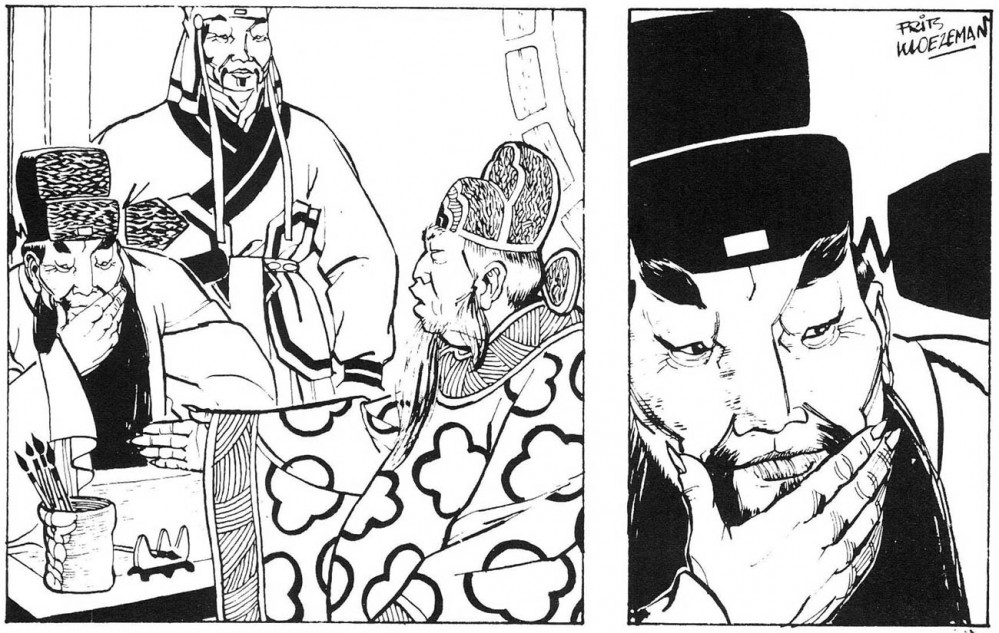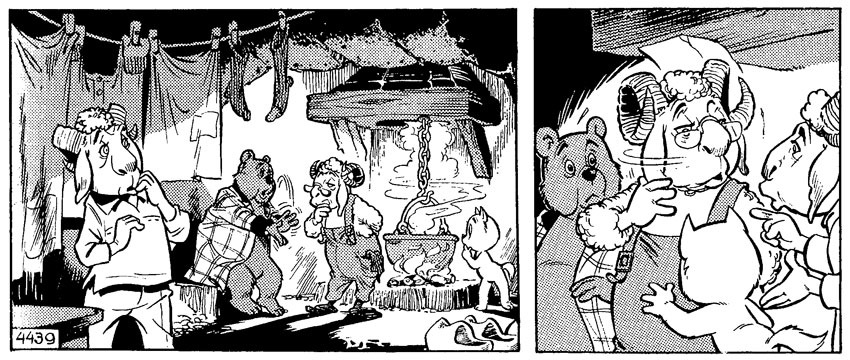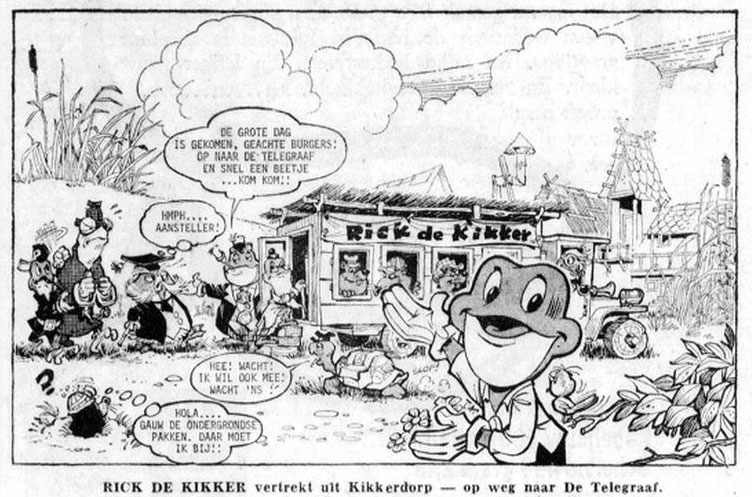Frits Kloezeman was a Dutch comic artist, who spent parts of the 1950s, 1960s and 1970s working for both the Toonder and the Geesink Studio's. After working as assistant or fill-in artist on funny newspaper comics like Loek van Delden's 'Smidje Verholen', Henk Kabos' 'Tekko Taks' and Marten Toonder's 'Tom Poes', he first found his trademark realistic style in his solo comic 'S.S. Anne' (1963). Between 1964 and 1969, he worked with the novelist and sinologist Robert van Gulik on a newspaper strip based on the semi-fictional historical magistrate and marshal Judge Dee ('Rechter Tie', 1964-1969), through Swan Features Syndicate. Kloezeman spent the final years of his career back at the Geesink Studio's, where he set up the 'Rick de Kikker' comic (1967) and participated in stop-motion animated series.
Early life
Frederik Ernest (Frits) Kloezeman was born in 1924 in Ipoh, Malaysia, where his Dutch father, Willem Jan Dirk Kloezeman (1891-1945), was stationed as a mining engineer. During his childhood, Kloezeman developed a great knowledge of Asian culture, as well as drawing. His artistic ambitions were encouraged by his family. Several of his brothers also became successful draftsmen and painters in adulthood. During World War II, Kloezeman served as a volunteer in the British Army. In 1942, he was captured by the Japanese, and spent the remainder of the war imprisoned in several camps on Java. To kill time, he made drawings of camp scenes on rice paper, most of which have been lost (another future cartoonist who was a Japanese POW prisoner was Ronald Searle, though he managed to save his art from the hands of his Japanese prison guards).
After World War II, Kloezeman achieved the military rank of Captain. In a 5 February 1983 interview with newspaper De Telegraaf, he said that on the day of the Japanese capitulation, his father died. Kloezeman tried to get the family mines back into operation, but with little success. After a couple of years, rebels blew up the mines, which motivated him to move to the Netherlands.
For the 'Tom Poes' story 'Het Boze Oog' (1961), Frits Kloezeman penciled the characters and Andries Brandt the backgrounds, while Marten Toonder did the inking.
Early career
In 1949, Kloezeman left the Orient and moved to The Netherlands to pursue a career in arts. After a short stint as an apprentice window dresser at the V&D department store, he found employment with Loek van Delden's AVAN Studios in The Hague, assisting as a clean-up artist on the popular newspaper comic 'Smidje Verholen'. Another Dutch comic artist working for Van Delden at the time was a young Jan van Haasteren. Kloezeman later moved to Joop Geesink's Dollywood Studios, where he spent most of the 1950s participating in the creation of advertising and puppet films. Through Geesink, he also made the promotional comic strip 'Piet Spriet en Ko de Koe', which appeared on the wrappers of Friesche Vlag bottles with condensed milk. In his spare time, Kloezeman also spent a year drawing the 'Tekko Taks' newspaper strip for Henk Kabos and James Ringrose, although precise dates are unknown. In 1959, Kloezeman left Geesink to start his own film studio, together with a friend. As this effort was not successful, he became a freelance illustrator for magazines and books instead.
Toonder Studio's
In 1961, Kloezeman was hired by the Toonder Studios, at the time the largest production house of comics and animation in the Netherlands. In the same year, he replaced Cees van de Weert as studio chief. In this position, he oversaw the studio's comic productions, but also contributed layout and pencil art himself. During the early 1960s, he assisted on the production of the daily episodes of Marten Toonder's 'Tom Poes en Heer Bommel' newspaper comic. His participation is known for at least the stories 'Het Boze Oog' (1961), 'De Niks' (1961-1962) and 'De Pikkinring' (1962). He also contributed to the weekly 'Tom Poes' comics produced for the Dutch Disney magazine Donald Duck. Kloezeman presumably also assisted on other Toonder newspaper comics like 'Kappie' and 'Koning Hollewijn'. While his early work on comics had been mostly funny animal material, Kloezeman switched to realism when writing and drawing two stories of 'S.S. Anne' (1963). Based on an idea by studio writer Lo Hartog van Banda, the feature was about an old steamship and ran in the newspaper De Telegraaf as well as the radio guide Tros Kompas. A third and final story of 'S.S. Anne' was drawn by Gerrit Stapel.
In the 2018 magazine series 'De Geschiedenis van de Toonder Studio's' by Jan-Willem de Vries, it is claimed that Kloezeman's tenure as studio chief made him very unpopular among the Toonder staff. He came across as pushy, overly critical and restless, acting as if he was better than the rest. During an argument, he once fired young artist Dick Matena, but Toonder reprimanded Kloezeman afterwards for this unauthorized deed, and Matena was sent back to his desk. As he had overplayed his hand, Kloezeman's position in the studio weakened. After two years, he left his job, but continued to draw the 'S.S. Anne' strip on a freelance basis. Eventually, he was replaced as studio chief by Ben van 't Klooster.
'Rechter Tie' (Utrechts Nieuwsblad, 4 January 1965).
Rechter Tie
In 1964, Kloezeman was hired away by the Swan Features Syndicate with an offer to draw a newspaper comic strip set in 7th century China. The artist's perfectionism and own experiences in China and Indo-China made him the ideal man for the job. This resulted in his best-known work in comics, the 'Rechter Tie' ('Judge Dee') series, based on stories by crime novelist and sinologist Robert H. van Gulik (1910-1967).
Ever since being stationed as a diplomat in China during the 1940s, Van Gulik had been writing novels with this historical character. His first book was an English translation of the 18th-century Chinese novel 'Dee Goong An', which appeared under the title 'Celebrated Cases of Judge Dee' (1949). It was an accurate account of the crime cases solved by an historical magistrate, minister and marshal during the Tang dynasty, whose name can be transcribed as Tie Jen-tsjiè, Di Renjiay, Dee Jen-chieh or Tie Jen-Shié, but is generally referred to in English as Judge Dee (630-700). As his translation was an instant hit, Van Gulik decided to write his own well-documented novels with Tang and Ming-era crime cases, which were first printed in Chinese and later also in English. Van Gulik himself provided illustrations for the book covers. Within no time, his fictionalized rendition of Judge Dee became a pop culture phenomenon, appearing in street theater, operas, films, and, in the Netherlands, also comics.
Between 1964 and 1969, Kloezeman drew 19 newspaper comics with 'Rechter Tie', distributed by Swan Features to regional Dutch newspaper comics. Kloezeman worked directly with writer Van Gulik, who provided copious amounts of text and descriptions, which the artist then reworked for the comic strip format. The first four episodes were balloon comics, the rest text comics, with text captions underneath the images. When in 1965 Van Gulik went to Tokyo to become the Dutch ambassador in Japan, crime novelist Ton Verstegen was brought in to write the stories based on Van Gulik's plots. Translations of the 'Rechter Tie' comics appeared in Australia, the Dutch Antilles, France and Italy. In 1967, one notable international publication was a colorized and reworked version of the episode 'Het Geheim van het Landhuis' for the Belgian comic magazine Spirou/Robbedoes (as 'Le Juge Ti').
In the newspaper strips, the character of Judge Dee was largely the same as in the Van Gulik novels. A brave and bearded strongman, equally capable in fighting with swords and sticks as he is in boxing. Intelligent, upright and correct, Dee is additionally a master of disguise. Although praised within literary and artistic circles, the 'Rechter Tie' comics were deemed too elitist and didactic by the general public, and ended after five years. In the early 1970s, the publisher Wolters-Noordhoff collected three stories in book format, followed in the early 1980s by an eight-volume pocket book series by publisher Loeb. A six-volume boxed set of all episodes was published by Boumaar in 2007. In 2000, the Dutch comic creator Dick Matena revived the character with a personal take on one of the earlier Kloezeman-Van Gulik episodes at publisher Arboris.
Announcement for the 'Rick de Kikker' strip in newspaper De Telegraaf (8 November 1967). Artist unknown, but possibly Frits Kloezeman.
Return to Geesink
By 1965, Kloezeman was re-employed at the Geesink Studios. One of his main projects was the development of the 'Rick de Kikker' comic strip ("Rick the Frog", 1967), based on a new puppet TV series produced by the Geesink team. In 1966 and 1967, the comic strip appeared in the Heintje comic paper of supermarket chain Albert Heijn, and later in 1967 also in the newspaper De Telegraaf. As Kloezeman oversaw production and penciled the backgrounds, the characters were drawn by Jan van Haasteren, after which Ton Beek inked the strips.
During this period, Van Haasteren also inked one of Kloezeman's 'Rechter Tie' stories. Through Geesink, both Frits Kloezeman and Jan van Haasteren provided the cartoons and illustrations for 'Zij Maakten Geschiedenis' (1973), a humorous book about the history of the Netherlands, written by Eli Asser and Patty Klein. The book tied in with the Sunday afternoon TV show 'NOS Kiosk'.
Throughout the rest of the 1960s and 1970s, Kloezeman participated in Geesink's stop-motion animated shorts starring the characters 'Loeki de Leeuw' ("Loeki the Lion") and 'Dusty'. Loeki in particular was popular among generations of TV viewers, since his stop-motion shorts were used as bumpers before and after commercial breaks on Dutch public television. Kloezeman also made illustrations and drew 'Loeki de Leeuw' comics, colored by Jan van Haasteren or Dino Candotti.
Final years and death
In 1980, Frits Kloezeman retired because of medical reasons. He died eight years later in his hometown Amsterdam, at the age of 64.









